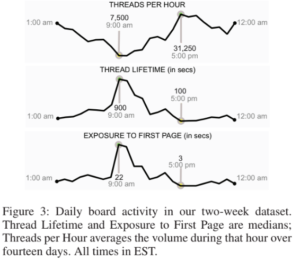Assigned reading: Cheng, Justin, Cristian Danescu-Niculescu-Mizil, and Jure Leskovec. “Antisocial Behavior in Online Discussion Communities.” Icwsm. 2015.
This paper talks about trolling and undesirable behavior in online discussion communities. Authors studied data from three online communities namely CNN, Breitbart and IGN to see how people behave in these large discussion based communities, with the aim to create a topology of antisocial behavior seen in such communities, and use it for early detection of trolls. Authors have used complete time stamped data of user activity and the list of total banned users on these websites for a course of one year obtained from Disqus.
Since services like Disqus help fetch data about user profiles, it would be interesting to have users’ demographics to observe whether age, geographical orientation has anything to their said anti-social behavior. These behaviors differ greatly from one community to another i.e. gaming, personal, religion, education, politics, and news communities. The patterns also vary in gender specific platforms.
Community bias is very real. In online discussion boards or groups on Facebook, people whose opinion differs from the admin/moderator are promptly banned. One person who is fairly harmless, in fact likeable in one group can be banned in the other. It has nothing to do with their content being profane, it’s more about a difference in opinion. There are also instances where people gang up against an individual and report/harass them in the name of friendship/gaining approval from the moderator or admin of the group. Analyzing or using such data to categorize users as trolls produces inequitable results.
Some other questions which need consideration are:
- There is a fairly large number of people (without quoting exact stats) who have more than one accounts on social media websites. What if the banned user rejoins the community with a different identity? Can the suggested model do early detection of such users based on historical data?
- Does the title correctly portray the subject matter of the study? As the word anti-social refers to someone who’s uncommunicative and avoids company, but based on the results it could be seen that FBU tend to not only post more, but they also have the capability of attracting more audience and steering the topic to their liking.
- Having read previous articles revolving around identities and anonymity, would the results be same for communities with anonymous users?
- How can we control trolling and profanity in communities such as 4chan, where the actual point of unison among seasoned (but anonymous) users is trolling new users and posting explicit content?
- Authors also try to assess whether excessive censorship makes the users hostile or antisocial. Considering real life instances such as teacher calling out and scolding student for someone else’s mistake, would there be some users who are likely to refrain from posting altogether when once treated unfairly?
